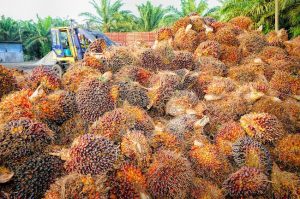News & Press, Plants, flowers & blossoms
Hot Topic: Palm oil

Apr
Palm oil was originally extracted from the oil palms of the West African rainforests. The fruits of the oil palm are about 4-5cm in size and reddish in colour, with firm yellowish flesh and a hard stone. Crude palm oil is pressed from the flesh of the palm oil fruit, while palm kernel oil is extracted from the stone.
Palm oil has many benefits and is the most widely used vegetable oil in the world. So why is palm oil suddenly seen by many as an absolute no-no?
The use of palm oil in cosmetics, food and as a fuel is highly controversial. The large-scale cultivation of oil palms has far-reaching consequences for humans, animals and the environment: indigenous peoples are displaced from their habitat by the cultivation of oil palms for large producers, access to clean water and air is restricted and financial dependence on palm oil producers often arises.
Other victims of the palm oil industry are endangered species such as tigers, rhinos, elephants and orangutans, as the habitat for the great apes is disappearing as the rainforest is cleared or burnt down to make way for oil palm plantations. The loss of natural rainforest is affecting Malaysia and Indonesia in particular. In addition, palm oil plantations accelerate climate change through greenhouse gas emissions.
For these reasons, more and more consumers are avoiding palm oil or non-certified palm oil. Yet it was precisely consumers who demanded palm oil as a healthier alternative to unhealthy fats and thus had a lasting influence on the food industry.
Currently, around half of all foods contain palm oil and the food industry plays a major role in palm oil production. The amount of palm oil varies from product to product, usually between 1% in bread, 4-5% in chocolate and pralines and up to 15% in sweet and savoury snacks. Conventional cosmetics also regularly contain palm oil.
The good news is that thanks to the strong voice of the consumer and more conscious shopping, the market is already moving: natural cosmetics manufacturers are either doing away with palm oil altogether or using certified and sustainable palm oil. The major food companies have also either already switched their production to sustainable palm oil, such as Nestlé, or are planning to do so in 2015, including PepsiCo, Unilever, Danone, Mars, Kellog's and others.
The internationally recognised standard for sustainable palm oil are the guidelines and certification of the RSPO (Roundtable on Sustainable Palm Oil) and in recent years the RSPO has grown from 10 to over 1,500 members from 50 countries. Approximately 15% of palm oil is sustainable and the area on which sustainable and RSPO-certified palm oil is grown is almost half the size of Switzerland!
At first glance, this sounds better than it is. Industry experts predict that many companies will not achieve the goal of switching to sustainable palm oil by 2015. However, the reason for this is not that there is not enough certified palm oil available, even if this is often put forward as a reason. Nor is the switch so expensive that the companies cannot afford it. The fact is that half of the sustainably produced palm oil could not be sold by the manufacturers. This disappoints the producers of certified palm oil and discourages other producers from also switching to sustainable production.
Fast Facts Palm oil:
- Palm oil is contained in a large number of products, from shampoo to biscuits to lipstick
- The palm oil industry directly and indirectly employs millions of people
- Conventional palm oil production can harm people, animals and the environment
- Around 60% of Swiss companies use RSPO-certified palm oil
You can do that:
- Buy products from companies that use RSPO-certified palm oil
- look for the RSPO seal on products and manufacturers' websites
- Ask shops, retailers, companies and businesses about sustainable and RSPO-certified palm oil
